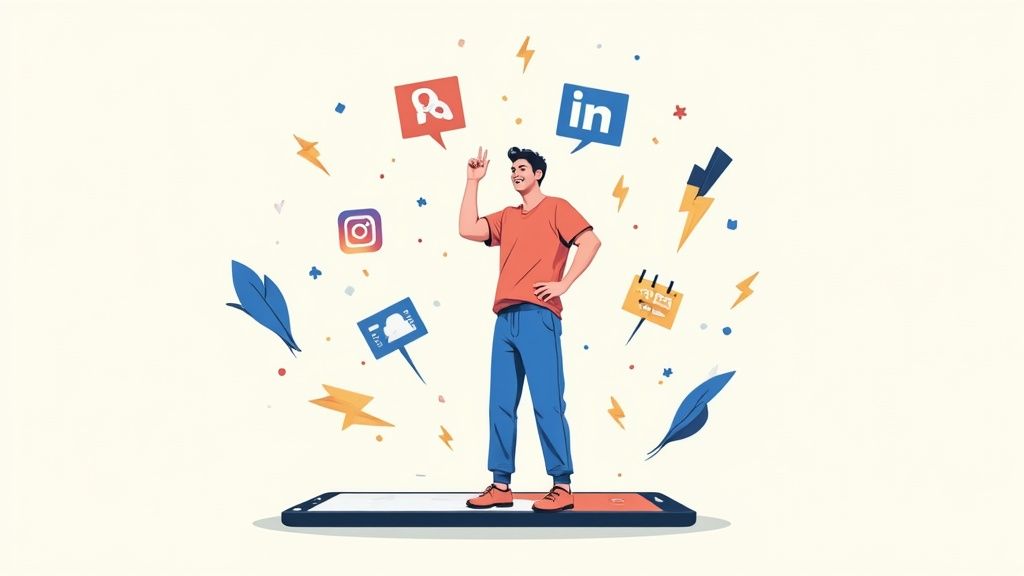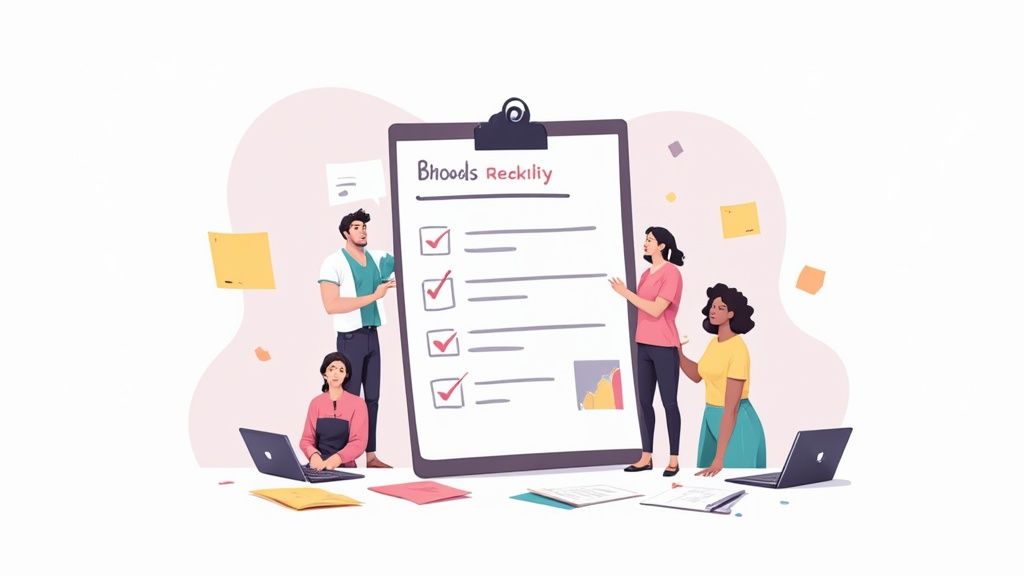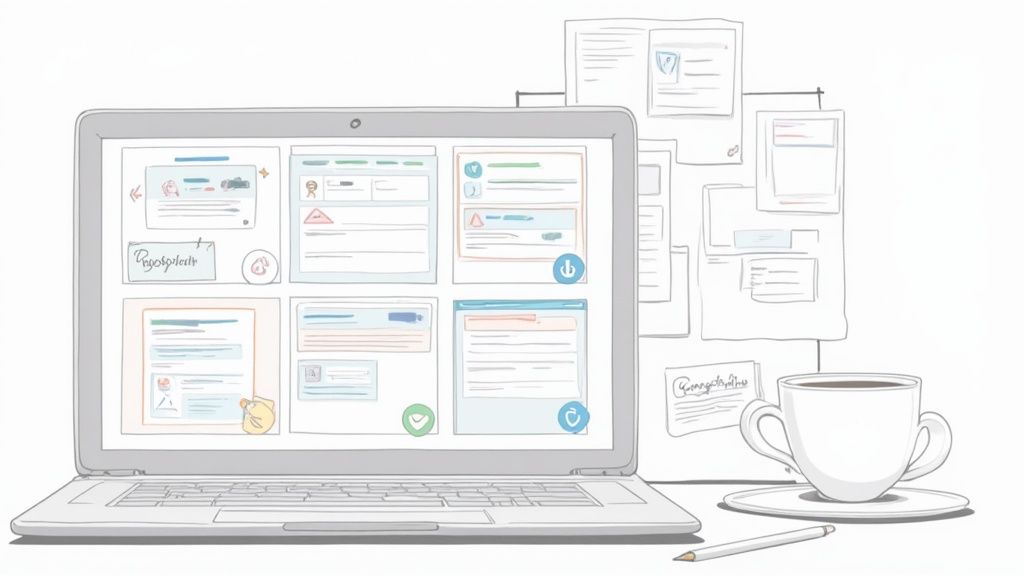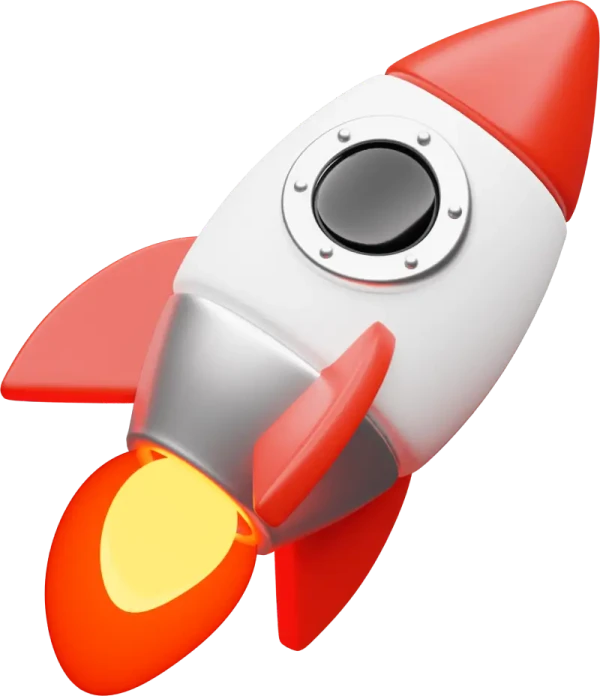Before you even think about hitting 'publish' on your first event post, you need a solid game plan. This isn't just about throwing a few posts out there and hoping for the best. It's about laying the groundwork by defining your goals, zeroing in on your audience, and picking the right social platforms where they actually hang out. A good plan is what turns followers into actual attendees.
Building Your Event Promotion Game Plan
Before all the fun of creating cool visuals and clever copy, the real work begins with some quiet, focused planning. We’ve seen it time and time again: a well-defined strategy is the number one thing that separates a sold-out event from an empty room. This pre-launch phase is where you build the entire framework for your promotion.
This is where you move past vague ideas like "getting the word out" and start thinking in terms of concrete, measurable results. Without clear objectives, you're flying blind. You have no way to know if what you're doing is actually working.
Define Your Goals and Audience
First things first: what does a "win" look like for this event? Your goals need to be specific and something you can actually count. Are you shooting for a certain number of ticket sales? A specific registration target for a webinar? Maybe a set engagement rate on your big announcement?
Here are a few examples of what we mean by clear objectives:
- Sell 500 tickets through social media before the early-bird price ends.
- Get a 5% click-through rate from our social posts to the registration page.
- Generate 1,000 uses of our official event hashtag before doors open.
Next up, you have to know exactly who you're talking to. Don't just skim the surface here; create a detailed attendee persona. Go beyond basic demographics and dig into their job titles, what they're interested in, and their online habits. Which social media platforms are they scrolling through every single day? Knowing this keeps you from wasting time and money on channels your audience couldn't care less about.
Think about it: if you're promoting a B2B tech conference, you’ll be living on LinkedIn. But if it's a local music festival, your best bet is going to be Instagram and TikTok.
A classic mistake is trying to be everywhere at once. When you truly understand your ideal attendee, you can pour all your energy and budget into the 2-3 platforms where they are most active and engaged.
Craft Your Core Message and Budget
Once you have your goals and audience locked down, you can start shaping your core message. This is the big idea that tells people why your event is worth their time and money. Why should they show up? What problem are you solving for them, or what one-of-a-kind experience are you offering? This message becomes the backbone of all your social media copy, from the very first teaser to the final "last chance to buy" posts.
If you need some inspiration, we've put together a guide full of unique event promotion ideas to get your creative juices flowing.
Finally, figure out your budget. It doesn't need to be some complex spreadsheet, but you should have a clear idea of what you can spend on things like paid ads, content creation tools, or even partnering with a few influencers. Having a budget from the start means you can make smart decisions to boost your reach when your organic efforts start to level off. This foundational work makes every other step you take way more effective.
Creating Social Content That Captivates and Converts
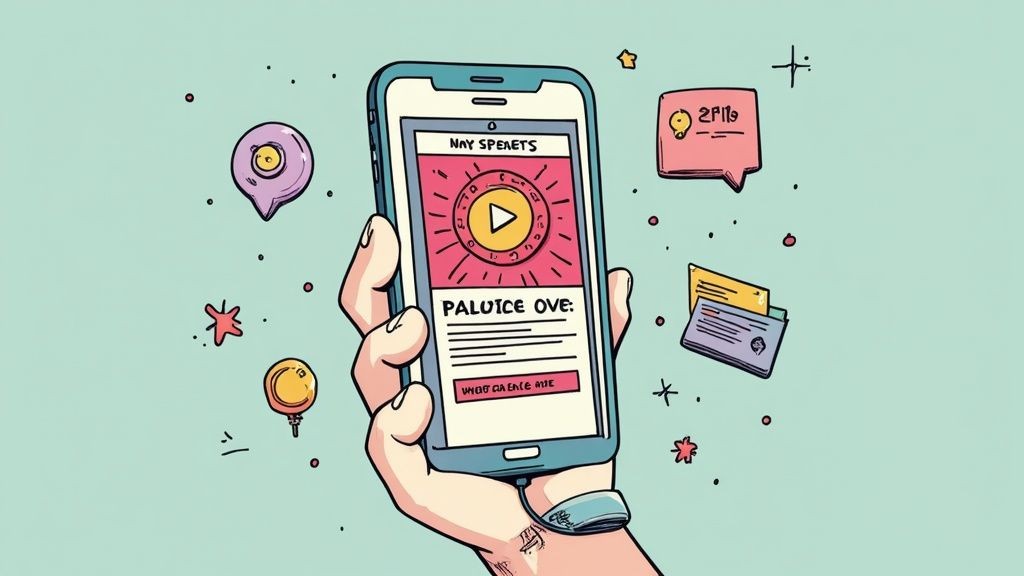
Alright, you've got your strategy mapped out. Now for the fun part: creating the actual content that stops the scroll and turns a "maybe" into a "heck yes!" This is where your event's story truly comes alive.
If you're just posting whenever you feel like it, you're leaving ticket sales on the table. A structured content calendar is your absolute best friend here. It's not just about scheduling; it's about building a narrative around your event.
Think of it like a movie trailer. You start with a big reveal (the announcement), build suspense with key deadlines (early-bird pricing), drop exciting teasers (speaker reveals, venue shots), and then hit them with a final sense of urgency (last-chance reminders). Each post is a scene that builds on the last.
Crafting a Compelling Content Mix
A killer promotion needs variety. If all you're doing is posting text updates, you're going to get lost in the noise. You need to create a journey for your audience, one that’s both visual and emotional.
Here are the non-negotiables for your content mix:
- Eye-Catching Graphics: Consistency is key. Create a few solid templates for things like speaker announcements, key quotes, or countdown graphics. This keeps your brand looking sharp and instantly recognizable across every platform.
- Short-Form Video: Honestly, this is a must-have, especially for Instagram Reels and TikTok. Think quick, snappy clips: behind-the-scenes prep, a 30-second interview with an organizer, or a high-energy recap from last year's event. These are attention-grabbing gold.
- Compelling Copy: Your words need to do some heavy lifting. Don't just inform - inspire. Your copy has to scream value and answer the one question on everyone's mind: "What's in it for me?"
The real goal here is to forge an emotional connection. Tell the story behind your event. Why does it exist? Who is it for? When people feel connected to your mission, they're not just buying a ticket; they're joining a community.
Scaling Content Creation with AI
Let's be real: churning out a constant stream of top-notch content is a grind. This is where modern tools can be a game-changer. Generative AI is like having a super-powered assistant who never needs a coffee break. It’s fantastic for brainstorming post ideas, knocking out first drafts of copy, or even suggesting visual concepts.
Think of it as a way to augment your creativity, not replace it.
Got writer's block? Feed your event details to an AI tool and ask it for ten different ways to promote a specific speaker. Boom - instant inspiration. This frees you up to spend more time on what really matters, like engaging with your community and thinking about the bigger picture.
The data doesn't lie, either. A whopping 90% of businesses using generative AI report saving a ton of time on content production. You can dive into more cool trends like this in these social media statistics.
Ultimately, your content should be a magnet, pulling in the right people by showing them exactly why your event is unmissable. By planning your milestones, mixing up your formats, and using tools to work smarter, you’ll build a campaign that doesn't just get seen - it gets results.
Choosing the Right Platforms to Promote Your Event
You've got amazing content ready to go. Now, the real work begins: getting it in front of the right eyeballs. Just blasting your event out everywhere is a surefire way to waste time and effort. The smart move is to pick your social media channels strategically - a choice that can honestly make or break your entire promotion.
Each network has its own vibe, its own audience, its own unwritten rules. A one-size-fits-all approach just doesn't fly. You'll get much more traction by focusing your energy where it counts. Instead of stretching yourself thin across five different platforms, find the one or two places where your ideal attendee actually hangs out and go all-in there.
Aligning Your Event with Platform Strengths
Think of social networks like different party venues. You wouldn't throw a formal corporate summit in a loud nightclub, right? The same logic applies online. The type of event you're hosting and the audience you're trying to attract should be the only things that guide your platform choice.
- LinkedIn: This is the undisputed king for B2B events, industry conferences, and professional workshops. The audience here is in a business mindset, actively looking to network and learn. It's the perfect place to share deep industry insights, spotlight your expert speakers, and use the official LinkedIn Events feature to make registration seamless.
- Instagram & TikTok: If your event has a strong visual or creative element - think music festivals, product launches, or art workshops - these are your go-to platforms. They're all about short-form video. Use Reels and TikToks to capture the energy of your event, share behind-the-scenes sneak peeks, and encourage user-generated content to build hype.
- Facebook: With its powerful Events feature and community-building tools, Facebook is still a fantastic all-rounder. It shines for local meetups, community gatherings, and webinars, especially when you can use a dedicated Facebook Group to keep the conversation going before, during, and after the event.
- X (formerly Twitter): Nothing beats X for real-time updates and live conversations. It’s ideal for quick-fire announcements, countdown posts, and creating a live buzz during the event with a dedicated hashtag. It's also a great channel for engaging directly with media and industry influencers.
Plotting out your posts on a simple calendar can be a game-changer for keeping your content plan organized and consistent across your chosen channels.
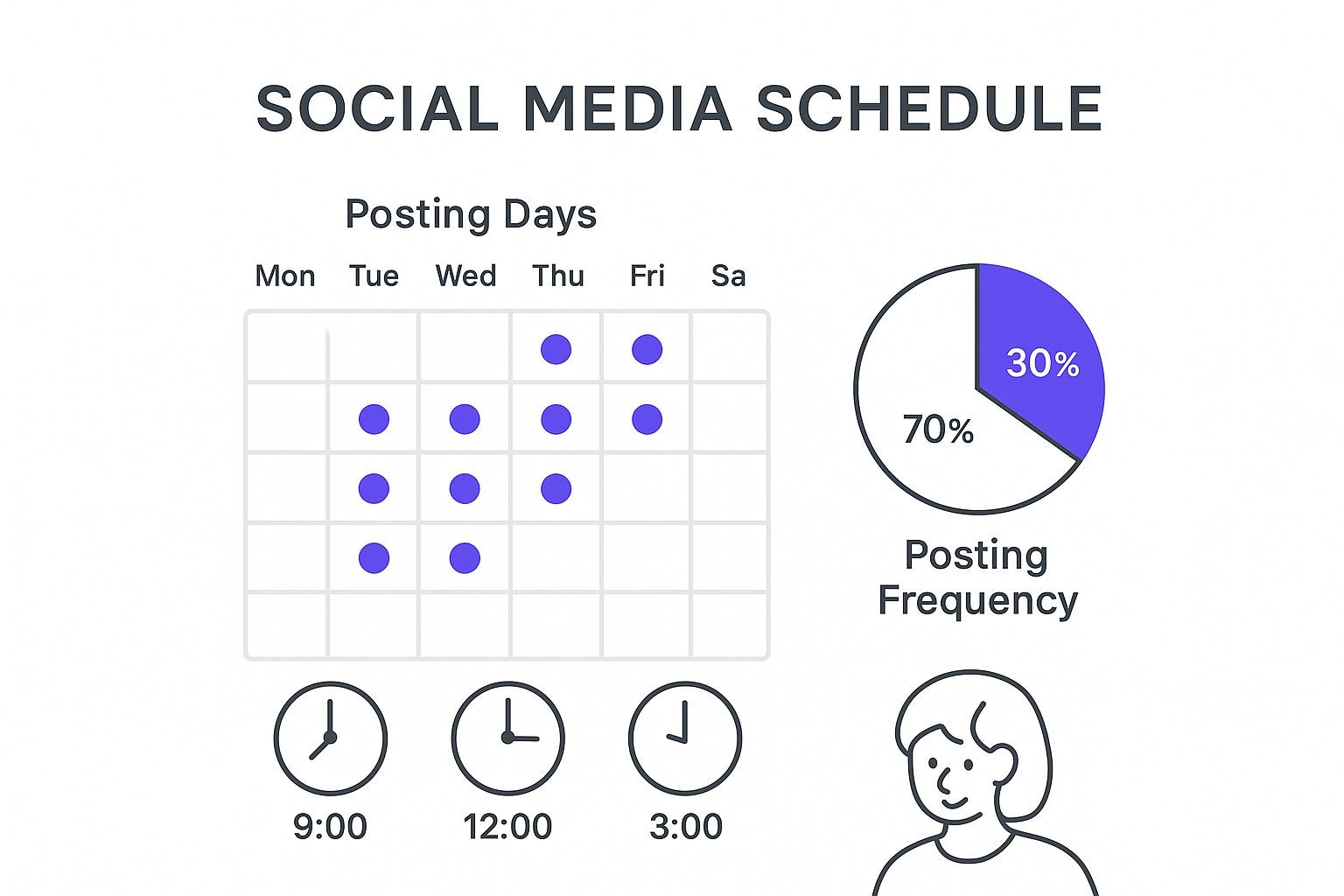
When you can see your schedule visually, it’s much easier to maintain a strategic and steady presence. For a deeper dive into building out your entire plan, check out our complete guide to social media event marketing.
Choosing the right platform is all about understanding where your audience lives online and what kind of content they expect to see there. To help you make the call, we’ve put together a quick comparison table.
Social Media Platform Strengths for Event Promotion
| Platform | Primary Audience | Best For | Key Feature |
|---|---|---|---|
| Professionals, B2B contacts, industry leaders | Conferences, webinars, workshops, corporate events | LinkedIn Events, professional networking, article publishing | |
| Millennials, Gen Z, creatives, B2C brands | Festivals, product launches, creative workshops, lifestyle events | Reels, Stories, high-quality visuals, influencer marketing | |
| Broad demographic, local communities, special interest groups | Local events, community gatherings, webinars, charity functions | Facebook Events, Groups, Live video, targeted ads | |
| TikTok | Gen Z, young millennials | Concerts, viral challenges, experiential events, brand activations | Short-form video, trends, user-generated content, high-energy clips |
| X (Twitter) | Journalists, tech industry, public figures, news followers | Live events, tech conferences, breaking news, Q&A sessions | Real-time updates, hashtags, live-tweeting, Spaces (audio) |
This table should give you a solid starting point. The goal isn't to be everywhere, but to be highly effective where it matters most for your specific event.
Let Data Guide Your Decision
Don't just go with a gut feeling. The data is clear: social media is the top channel for event promotion, with 83% of marketers using it to drive registrations. While Facebook, Instagram, and LinkedIn are often the heavy hitters, the real magic happens when you get specific.
Dive into your own analytics. Where do your followers actually engage with you? Which platform drives the most clicks to your website? Find that sweet spot and double down. By matching your event's style to a platform's strengths, your message will hit home, drive real engagement, and ultimately, put more people in the seats.
How to Keep Your Audience Engaged Before, During, and After an Event
If you want to really promote an event on social media, you have to stop thinking of it as a broadcast and start treating it like a conversation. Real engagement isn't a happy accident; it’s a deliberate, three-phase strategy that turns passive followers into a genuine community.
The whole point is to build a wave of momentum that starts with the very first announcement and carries you all the way through the post-event wrap-up.
It all kicks off by building buzz long before the doors even open. This is your shot to create a real sense of anticipation. Start a countdown in your Instagram Stories or run a few interactive polls on LinkedIn asking what people are most excited to see. This isn't just fluff - it gives you a goldmine of insight into what content will actually land with your audience.
Phase 1: Pre-Event Buzz and Anticipation
The pre-event phase is all about making your audience feel like they're on the inside track. It's the perfect time to build hype and clearly show the value they’ll get from showing up.
Here’s how you do it:
- Host Speaker Q&As: Schedule short, live Q&A sessions with your key speakers. This puts a human face to the event and gives potential attendees a direct line to ask questions, which makes them feel way more connected.
- Share Behind-the-Scenes Content: Post quick videos of your team in setup mode, speakers prepping their talks, or even just a sneak peek of the venue. This kind of raw, authentic content creates that "you had to be there" feeling.
- Run a Giveaway: Nothing gets people moving like free stuff. Offer a ticket upgrade or a special prize to a lucky winner who shares your event post or tags a friend. It's a simple, but ridiculously powerful, way to expand your reach without spending a dime.
The real trick here is turning promotion into participation. When you ask for opinions, feature speakers, and create shareable moments, your audience stops being spectators and starts becoming part of the event's story.
Phase 2: Real-Time Connection During the Event
On the day of the event, your social media channels should be the central hub of all the action. Your job is to capture the energy in the room (or in the virtual chat) and blast it out to the world.
This keeps the people who are there engaged and, just as importantly, creates a massive dose of FOMO (fear of missing out) for everyone who isn't.
Live-tweeting key quotes and takeaways from sessions is a classic for a reason - it just works. Use your official event hashtag religiously and get everyone else to do the same.
Make a point to curate and share the best user-generated content in real-time. When an attendee posts a great photo or a sharp insight, reshare it immediately. This simple act of acknowledgment makes people feel seen and it always encourages more sharing.
Phase 3: Post-Event Momentum and Community Building
Don't make the mistake of going silent the second the event ends. The post-event phase is your golden opportunity to cement the experience in people's minds and keep the conversation going.
Get a high-energy highlight reel out within a day or two. It should be a quick-cut video capturing all the best moments.
Post attendee testimonials - and make sure you tag them! This is incredibly powerful social proof for your next event.
Finally, use this period of high engagement to drop an early announcement about what’s next. Maybe it's access to session recordings, a follow-up webinar, or a save-the-date for next year. This bridges the gap and turns a one-time event into a lasting experience with your brand.
Amplify Your Reach with Paid Ads and Influencers
Your organic content is the bedrock of your event promotion, but at some point, you'll hit a ceiling. Relying only on your existing followers for reach is like trying to fill a stadium by only inviting your friends.
To break through that ceiling and pull in a much larger, highly-targeted crowd, you need to make some smart, strategic investments. This is where paid social ads and influencer marketing come in.
This isn't about just throwing money at the problem; it's about precision. Paid advertising on platforms like Facebook, Instagram, and LinkedIn lets you get incredibly specific with your targeting. You can go way beyond basic demographics and put your message right in front of people based on their job titles, what they're interested in, their online behavior, and even events they’ve attended before.
Demystifying Paid Social Advertising
Think of paid ads as a high-powered spotlight for your event. Instead of just hoping the right people stumble across your post, you can shine that light directly on them. The real magic of these platforms is their uncanny ability to find your ideal attendee.
Let's say you're promoting a marketing conference. You can set up your ads to target users who follow top industry leaders, are members of specific marketing groups on Facebook, or literally have "Marketing Manager" in their job title on LinkedIn.
This level of detail is what makes it work. You're not wasting your ad spend on people who will never be interested. Instead, every dollar goes toward attracting qualified leads who are far more likely to click that "buy ticket" button.
A good starting point is to test the waters with a modest budget. Try out a few different ad creatives and audience segments. See which ad gets you the lowest cost per click or the highest number of registrations. Once you find that winning combination, you can feel confident turning up the dial on your spending.
The ad campaigns that really kill it are the ones that don't feel like ads at all. They feel like a genuinely helpful piece of content. Focus on the experience and the benefits you're offering, not just a hard sell.
Unpacking the Power of Influencer Marketing
Beyond running your own ads, partnering with the right influencers can be an absolute game-changer. This strategy taps into the immense power of trust and social proof. When an authentic creator your audience already follows recommends your event, that endorsement carries a ton of weight.
But here’s the crucial part: you have to find the right fit. Don't get distracted by huge follower counts. The best, most impactful collaborations happen when a creator's audience is a perfect match for your ideal attendee.
This is often where micro-influencers steal the show.
These creators might have smaller, more niche followings, but their engagement rates are typically through the roof. In fact, micro-influencers (those with 10K-100K followers) see average engagement rates of 3.86% on Instagram. That blows past the 1.21% that macro-influencers get.
For your event, that higher engagement translates directly into a more passionate, responsive audience. These partnerships offer a fantastic return, with influencer marketing projected to bring in about $5.78 for every $1 spent in 2025. You can dive deeper into these trends in this detailed report on social media marketing statistics.
Just one strategic partnership can open the door to a highly relevant community, often leading to a massive surge in both visibility and ticket sales. When you combine targeted paid ads with authentic influencer collaborations, you create a powerful one-two punch that ensures your event reaches its full potential.
Measuring Your Success to Improve Future Promotions
So, the confetti has settled, and the last thank-you email has been sent. Now what? How do you really know if your social media push was a success? If you want to make sure your next event is even bigger and better, you have to move past gut feelings and vanity metrics.
This is where you put on your detective hat and dig into the data. You need to know which posts actually drove ticket sales, which platforms brought in the most engaged crowd, and what content truly connected with people. Without this deep dive, you’re just guessing, and that’s a risky way to plan your next big thing.
Identifying Your Key Performance Indicators
First things first, let's focus on the numbers that actually matter. A mountain of likes feels great, but it doesn't pay the bills. Your key performance indicators (KPIs) should tie directly back to the goals you set way back in the planning stage.
Here are the core metrics we always keep an eye on:
- Conversion Rate: This is the big one. It's the percentage of people who took the action you wanted - like buying a ticket or registering - after clicking a link in your social post.
- Click-Through Rate (CTR): This tells you how many people who saw your post were intrigued enough to actually click on it. A low CTR is often a sign that your copy or visuals just aren't hitting the mark.
- Cost Per Acquisition (CPA): If you ran paid ads, this metric is non-negotiable. It tells you exactly how much you spent to get one registration or ticket sale, which is essential for judging the real financial return on your ad spend.
To get this kind of clarity, you absolutely have to use UTM parameters. These are just simple tags you add to your links that tell your analytics tools which platform, campaign, and even which specific post sent someone to your registration page. It’s how you get crystal-clear data on what’s working and what’s not.
Tracking data isn't just about creating a report card for your last event. It’s about gathering intelligence to make smarter, more effective decisions for your next one. Every number tells a part of the story.
Gauging Genuine Interest Beyond Clicks
Sometimes, a click doesn’t tell the whole story. A powerful, yet often overlooked, metric is tracking genuine intent. How many people didn't just see your event but actively planned to attend? This is an area we've focused heavily on with our service.
By integrating "add to calendar" buttons directly into your social posts, landing pages, and confirmation emails, you give your audience a simple, one-click way to commit. For you, this provides an invaluable metric for gauging real interest before a ticket is even purchased. If you're looking for more strategies like this, our guide on how to promote an event online offers additional insights.
When you analyze this "add to calendar" data alongside your sales figures, you get a much richer picture of what's happening.
You might discover that your Instagram Stories generated a huge number of calendar adds but fewer sales. That signals high interest but points to potential friction on your ticket page. Armed with that kind of insight, you can start refining every piece of your promotion, ensuring your next event isn’t just seen - it’s attended.
Burning Questions Answered
When you're deep in the trenches of event promotion, a lot of questions pop up. We've been there. Here are some quick, no-nonsense answers to the most common puzzles we see marketers grappling with.
When Should I Actually Start Promoting My Event?
This is a classic "it depends" question, but we can give you some solid rules of thumb. The timeline really hinges on the size and scope of your event.
For a big-ticket conference or a multi-day festival, you need a long runway. Start making noise 3 to 4 months out. This gives you the breathing room to build a real narrative - from the initial announcement and early-bird ticket rush, to dropping speaker reveals and building up to a final, can't-miss-it surge.
On the flip side, for smaller gatherings like a webinar or a local meetup, you don't need to play such a long game. Kicking things off 4 to 6 weeks beforehand is usually the sweet spot. It's enough time to get the word out and build excitement without your audience getting tired of hearing about it.
What's the One Metric I Absolutely Have to Track?
Look, things like reach and engagement are nice to have. They tell you people are seeing your stuff. But the one number that really matters? Your conversion rate.
This is the metric that ties directly back to your goal. It’s the number of ticket sales, registrations, or whatever action you're driving. It tells you if your social media efforts are actually putting butts in seats.
To get this number right, you have to be religious about using UTM tracking links for every single post. Seriously. It’s the only way to definitively know which platform, which campaign, or even which specific Tweet is making the cash register ring.
How Do I Get People to Post About the Event During the Event?
Turning your attendees into a volunteer marketing army is one of the most powerful things you can do. The key is to make it easy and fun for them.
First, come up with an official event hashtag. Keep it short, make it unique, and plaster it everywhere - on projector screens, in your emails, on lanyards, everywhere.
Then, you have to give them something cool to share.
- Create "Instagrammable" moments. Think designated photo booths, a cool backdrop with great lighting, or a unique piece of art.
- Gamify it. Run a contest for the best post using the hashtag. The prize doesn't have to be huge - a free ticket to next year's event often does the trick.
- Engage, engage, engage. When you see people posting, jump on it! Reshare their stories and posts in real-time. It's a small gesture that makes people feel seen and encourages a ripple effect.
When attendees see you highlighting their content, it makes them feel seen and valued. This simple act of real-time engagement is often the most effective way to spark a wave of user-generated content.
Paid Ads or Influencers: Where Should I Spend My Money?
This isn't an either/or question. The smartest play is almost always a mix of both. They do different jobs, and they do them well.
Paid ads are your precision tool. Nothing beats them for hyper-targeting. You can dial in your exact audience based on demographics, interests, and behavior to make sure your message lands in front of the people most likely to buy a ticket.
Influencers, on the other hand, bring the human element and social proof. They can introduce your event to their loyal followers in a way that feels like a genuine recommendation from a friend. If your budget is tight, don't overlook micro-influencers. These folks often have smaller but incredibly engaged audiences in a specific niche, delivering a fantastic return on your investment.
Make every social media post more effective by giving your audience a direct path from interest to attendance. With our service, you can easily embed "add to calendar" buttons into your posts and landing pages, capturing genuine commitment and simplifying the user experience.
